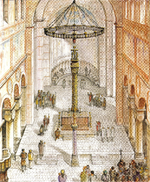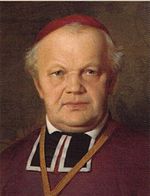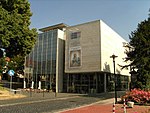Inkpot Madonna
1430s sculpturesGothic sculpturesHildesheim CathedralStatues of the Madonna and ChildWooden sculptures in Germany

The Inkpot Madonna (German: Tintenfassmadonna) is a late-Gothic sculpture of Mary in the Hildesheim Cathedral, a building on the UNESCO World Cultural Heritage list since 1985, which is consecrated to the Assumption of Mary. The coloured life-size wooden statue was created around 1430, probably in Lower Saxony, and has the hallmarks of the international Gothic style: a tender face, loose posture and flowing drapery.
Excerpt from the Wikipedia article Inkpot Madonna (License: CC BY-SA 3.0, Authors, Images).Inkpot Madonna
Domhof, Hildesheim Altstadt (Stadtmitte/Neustadt)
Geographical coordinates (GPS) Address Website Nearby Places Show on map
Geographical coordinates (GPS)
| Latitude | Longitude |
|---|---|
| N 52.1489 ° | E 9.9464 ° |
Address
Hoher Dom St. Mariä Himmelfahrt
Domhof 17
31134 Hildesheim, Altstadt (Stadtmitte/Neustadt)
Lower Saxony, Germany
Open on Google Maps










